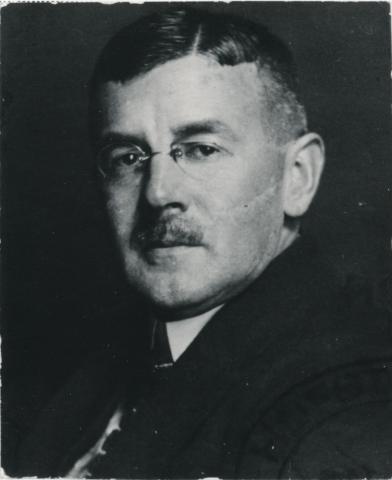Karl Wagner studied philosophy and German at the University of Vienna, where he was awarded a doctorate in 1911. He started working for the city of Vienna in 1909 and in January 1912 was assigned to the Städtische Sammlungen. During his studies he had belonged to a fraternity and under the Austrofascists he was a member of the Vaterländische Front (Fatherland Front). In 1938 he joined the Reichsbund der Deutschen Beamten (Reich Association of German Officials) and the Nationalsozialistische Volkswohlfahrt (National Socialist People's Welfare), but never joined or applied for membership of the NSDAP. After the forced retirement of Oskar Katann, the supposedly unreliable director of the Städtische Sammlungen / Historisches Museum der Stadt Wien in November 1938, Wagner, until then deputy director, took over his position. His written appointment followed on 27 June 1939. According to the political assessment by the NSDAP, he was described as "in harmony with the Party and state". Although not a Party member, this probably explains how he managed to retain this function until the end of the Nazi rule and beyond until his retirement on 1 September 1949. Wagner was very interested in acquiring objects formerly owned by Jews. In a letter to the mayor of Vienna in January 1939, he pointed out that "a movement had occurred in the art market through the Jewish emigration that had not been seen since the dissolution of the monasteries in 1782" and that this offered a "favourable opportunity". He requested art objects from the Aryanized collections of Oscar Bondy, Leopold Weinstein, Ferdinand Bloch-Bauer and Serena Lederer and in other cases exploited the difficult position of the Jews to acquire objects for the Städtische Sammlungen cheaply. Until 1945, objects were repeatedly acquired, either as gifts or through purchase, from Vugesta (Gestapo Office for the Disposal of the Property of Jewish Emigrants) or from Julius Fargel, a painting restorer at the Städtische Sammlungen and treasurer of Vugesta. Wagner must have known that they had belonged formerly to Jews. He was motivated not only by the desire to add to the collections but also by the Nazi race and culture policy. In the case of the pictures by the Jewish painter Wilhelm Viktor-Krausz he argued that works by Jewish artists "whose painting style and attitude are rejected today" were important for German collections because exhibitions, "be it for antisemitic or educational purposes", could be organized and also because these pictures would not thus be available "to foreign Jews for propaganda or chauvinistic Jewish purposes". Wagner was also responsible as director for the storage of objects from the museum during the war and for the return and repair of damage afterwards. As he remained in office until his retirement in 1949, he also had to deal with the first restitution claims by surviving Jews. He did his utmost to refute the claims and to present his acquisitions as completely legal. In the case of the Biedermeier bedroom furniture belonging to Stefan Poglayen-Neuwall, which Wagner had acquired by exploiting his knowledge of the family's Jewish roots, warning Poglayen-Neuwall that it was "up to him how the museum acquired the furniture", he denied the coercive nature of the sale, disputed the legality of additional payment and refused any kind of settlement. When questioned on two occasions by the Property Control Sub-Section in February and May 1947, he claimed that the Städtische Sammlungen had never purchased objects during the Nazi era, except for those allocated to it by the Denkmalamt (monuments office), of "proven Jewish ownership" and that such objects had been secured only to prevent the cheap sale of Jewish property. Wagner retired on 1 September 1949 and left office with all honours.
Karl Wagner

Dritter Bericht des amtsführenden Stadtrates für Kultur und Wissenschaft über die gemäß dem Gemeinderatsbeschluss vom 29. April 1999 erfolgte Übereignung von Kunst- und Kulturgegenständen aus den Sammlungen der Museen der Stadt Wien sowie der Wiener Stadt- und Landesbibliothek vom 21. November 2002 (Restitutionsbericht 2002), URL: www.wienmuseum.at/fileadmin/user_upload/PDFs/Restitutionsbericht_2002.pdf (3.12.2020).
Vierter Bericht des amtsführenden Stadtrates für Kultur und Wissenschaft über die gemäß dem Gemeinderatsbeschluss vom 29. April 1999 erfolgte Übereignung von Kunst- und Kulturgegenständen aus den Sammlungen der Museen der Stadt Wien sowie der Wiener Stadt- und Landesbibliothek vom 10. November 2003 (Restitutionsbericht 2003), URL: www.wienmuseum.at/fileadmin/user_upload/PDFs/Restitutionsbericht_2003.pdf (3.12.2020).
Fünfter Bericht des amtsführenden Stadtrates für Kultur und Wissenschaft über die gemäß dem Gemeinderatsbeschluss vom 29. April 1999 erfolgte Übereignung von Kunst- und Kulturgegenständen aus den Sammlungen der Museen der Stadt Wien sowie der Wiener Stadt- und Landesbibliothek vom 22. November 2004 (Restitutionsbericht 2004), URL: www.wienmuseum.at/fileadmin/user_upload/PDFs/Restitutionsbericht_2004.pdf (3.12.2020).
Dieter J. Hecht, Die Mitarbeiterinnen und Mitarbeiter des Historischen Museums der Stadt Wien während der NS-Zeit, in: Wiener Geschichtsblätter. Hrsg. vom Verein für Geschichte der Stadt Wien 71 (2016) 2, 95–112.
Eva Maria Pammer-Salzmann, Dir. Karl Wagner, in: Hundert Jahre Historisches Museum der Stadt Wien. Katalog zur 106. Sonderausstellung des Historischen Museum der Stadt Wien, Wien 1987.
